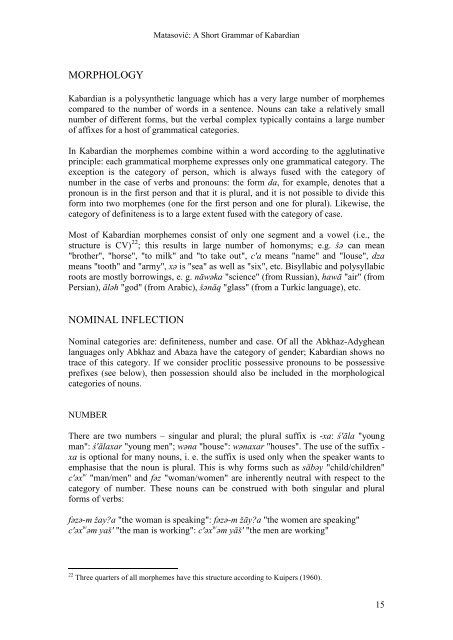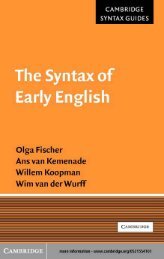PREGLED KABARDINSKE GRAMATIKE - Cryptm.org
PREGLED KABARDINSKE GRAMATIKE - Cryptm.org
PREGLED KABARDINSKE GRAMATIKE - Cryptm.org
You also want an ePaper? Increase the reach of your titles
YUMPU automatically turns print PDFs into web optimized ePapers that Google loves.
Matasović: A Short Grammar of KabardianMORPHOLOGYKabardian is a polysynthetic language which has a very large number of morphemescompared to the number of words in a sentence. Nouns can take a relatively smallnumber of different forms, but the verbal complex typically contains a large numberof affixes for a host of grammatical categories.In Kabardian the morphemes combine within a word according to the agglutinativeprinciple: each grammatical morpheme expresses only one grammatical category. Theexception is the category of person, which is always fused with the category ofnumber in the case of verbs and pronouns: the form da, for example, denotes that apronoun is in the first person and that it is plural, and it is not possible to divide thisform into two morphemes (one for the first person and one for plural). Likewise, thecategory of definiteness is to a large extent fused with the category of case.Most of Kabardian morphemes consist of only one segment and a vowel (i.e., thestructure is CV) 22 ; this results in large number of homonyms; e.g. šə can mean"brother", "horse", "to milk" and "to take out", c'a means "name" and "louse", dzameans "tooth" and "army", xə is "sea" as well as "six", etc. Bisyllabic and polysyllabicroots are mostly borrowings, e. g. nāwəka "science" (from Russian), hawā "air" (fromPersian), āləh "god" (from Arabic), šənāq "glass" (from a Turkic language), etc.NOMINAL INFLECTIONNominal categories are: definiteness, number and case. Of all the Abkhaz-Adygheanlanguages only Abkhaz and Abaza have the category of gender; Kabardian shows notrace of this category. If we consider proclitic possessive pronouns to be possessiveprefixes (see below), then possession should also be included in the morphologicalcategories of nouns.NUMBERThere are two numbers – singular and plural; the plural suffix is -xa: ś'āla "youngman": ś'ālaxar "young men"; wəna "house": wənaxar "houses". The use of the suffix -xa is optional for many nouns, i. e. the suffix is used only when the speaker wants toemphasise that the noun is plural. This is why forms such as sābəy "child/children"c'əx w "man/men" and fəz "woman/women" are inherently neutral with respect to thecategory of number. These nouns can be construed with both singular and pluralforms of verbs:fəzə-m žay?a "the woman is speaking": fəzə-m žāy?a "the women are speaking"c'əx w əm yaš' "the man is working": c'əx w əm yāš' "the men are working"22 Three quarters of all morphemes have this structure according to Kuipers (1960).15
















